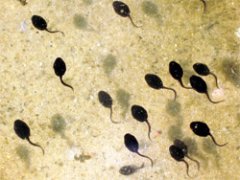Environmental Issues with Pesticides
 When chemicals that are designed to kill are introduced into delicately balanced ecosystems, they can set damage in motion that reverberates through the food web for years.
When chemicals that are designed to kill are introduced into delicately balanced ecosystems, they can set damage in motion that reverberates through the food web for years.
- Honeybee populations are plummeting nationwide.
- Male frogs exposed to atrazine become females.
- Pesticides are implicated in dramatic bat die-offs.
Pesticides wreak havoc on the environment, threatening biodiversity and weakening the natural systems upon which human survival depends. PAN works hard to promote agricultural systems that protect and strengthen, rather than contaminate, our natural ecosystems.
Bees, Bats & Frogs Dying Off in Droves
Five great extinction events have reshaped earth in the past 439 million years, each wiping out between half and 95% of planetary life. The most recent was the killing off of dinosaurs. Today, we're living through a sixth great cataclysm. Seven in ten biologists believe that mass extinction poses an even greater threat to humanity than the global warming which contributes to it.
Amphibians were the first to start dying off – in 1998 scientists identified the cause as a type of fungus, with population declines showing a strong correlation to pesticide exposure. A few years later America’s honeybees started dying – populations have dropped by 29% - 36% each year since 2006 (see below).
Bee populations have dropped 30% per year since 2006.
Bats are the most recent victims. In 2006 the first cave floors were found covered with dead bats in the Northeast. Some scientists believe that like amphibians, bats have become more susceptible to deadly disease (in this case, White Nose Syndrome) because their immune systems are weakened by pesticides. A growing body of evidence points towards pesticide exposure – even at so-called “safe levels” – as a key contributor to these and other problems for wildlife.
Mystery of Disappearing Honeybees
Without bees, say goodbye to almonds, peaches - even chocolate. Fully 1/3 of the food we eat depends on bees for pollination. So when the insects suddenly started dying off and abandoning their hives in 2006, scientists, beekeepers and farmers sounded the alarm. Researchers dubbed the phenomenon “Colony Collapse Disorder, ” and went to work trying to find a cause.










